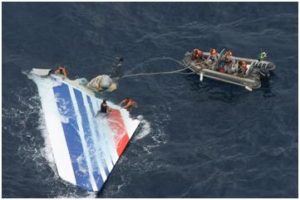The Agility Gap

 The demands upon our agility these days often exceed our ability to supply. That leaves an agility gap, as an organization, as a team and as an executive.
The demands upon our agility these days often exceed our ability to supply. That leaves an agility gap, as an organization, as a team and as an executive.
Often we learn of this gap with 20/20 hindsight (What Just Happened? (and the cost of 20/20 hindsight)). Sometimes with the stark clarity of a disaster, such as an aircraft accident:
- Details are just emerging from the investigation of Air France Flight 447, which plunged into the Atlantic Ocean in June 2009 on its way from Brazil to France. Having recovered the crash protected flight data and cockpit voice recorders in May 2011, after almost 2 years on the seabed, analysis of the data is now revealing that the cockpit crew experienced an agility gap. In less than four minutes, a complex combination of systems and multiple improbable factors tested the real-time agility skills of the crew and, tragically, they failed the test. Now with 20/20 hindsight of new skills and training required to deal with the complexity of modern aircraft and certain real-time, unfolding situations.
- Another famous accident is that of Eastern Airlines Flight 401 on December 29th 1972. Read more at video at The Eastern Airlines Story, including a reconstruction video. That cockpit crew also experienced an agility gap, unable to deal with the agility demands of a real-time, unfolding complex situation.
Indeed, in their 2010 Global Study of 1,541 CEOs, entitled, “Capitalizing on Complexity” IBM identifies a similar agility gap in business:
- “In 2010, our conversations identified a new primary challenge: complexity. CEOs told us they operate in a world that is substantially more volatile, uncertain and complex. Many shared the view that incremental changes are no longer sufficient in a world that is operating in fundamentally different ways. Today’s complexity is only expected to rise, and more than half of CEOs doubt their ability to manage it. Seventy-nine percent of CEOs anticipate even greater complexity ahead.
- “However, one set of organizations — we call them “Standouts” — has turned increased complexity into financial advantage over the past five years.
- “Complexity should not be viewed as a burden to be avoided; we see it as a catalyst and an accelerator to create innovation and new ways of delivering value.” Juan Ramon Alaix, President, Pfizer Animal Health
Will you standout in bridging this agility gap? Blockbuster, the video store chain, didn’t. Crashed and burned! Borders, the book store, didn’t. Crashed and burned! And so many more, banks, retailers, and other businesses we could mention. Crashed and burned! General Motors didn’t for a long time, but maybe they have finally woken up. Will you view the agility gap as a burden or an opportunity to be embraced? Will you see it as a catalyst and accelerator of value? To capitalize on the new complexity involved, we need to see it differently, looking at this new normal through new lenses (Putting on our 3D Glasses: New Lenses for the New Normal of our Agility Challenge).
Category: Leadership
Tags: Agility, Agility gap, Business, Executive, team

